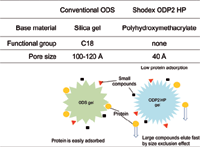Direct Analysis of Drugs in Biofluids
The Application Notebook
Sample pretreatment is often a time consuming and labor-intensive step which can be a restricting factor for the rapid analysis. This is especially true for the analysis of drugs in biofluids containing many interfering matrices.
Sample pretreatment is often a time consuming and labor-intensive step which can be a restricting factor for the rapid analysis. This is especially true for the analysis of drugs in biofluids containing many interfering matrices. Shodex ODP2 HP, a polymer-based reversed-phase HPLC column was used to develop a direct analysis method for drugs in biofluids. The ODP2 HP column has a unique feature of retaining hydrophilic target compounds while excluding large biological matrices prior to the elution of targets (Table I). The feature was effectively used in this method.

Table I: Comparison of conventional ODS columns and Shodex ODP2 HP column
Experimental Conditions
Blood serum, urine, and gastric juice samples were collected from suspected drug-poisoned patients transported to the emergency and critical care medicine.
The following conditions were used. Column; Shodex ODP2 HP-4D (4.6 mm i.d. × 150 mm L) or ODP2 HP-4E (4.6 mm i.d. × 250 mm L). Eluent; a mixture of 0.1% TFA and CH3CN. Flow rate; between 0.3 and 0.6 mL/min. Injection volume; from 5 to 10 µL. Detector; UV, optimal single wavelength was selected from a range between 215 and 272 nm. Column temperature; 40 °C. Standards were prepared in the eluent. Biological sample was injected directly without any pretreatment or dilution. Optimal analytical condition for each target and biofluids varied slightly. For the identification purpose, each peak was fractionated, and then injected directly to a mass spectrometer.
Results
Figure 1a shows baseline separation of typical drug components in cold medicines. Serum collected from a poisoned patient was analyzed and several drugs were detected without the influence of biological matrices (Figure 1b). Drugs found in the serum were 44.1 µg/mL acetaminophen, 11.0 µg/mL dihydrocodein phosphate, and 22.6 µg/mL acetylsalicylic acid. A small amount of salicylamide and salicylic acid was also found. In one case of accidental insecticide poisoning, imidacloprid was detected in the patient's gastric juice. In another case, risperidone was detected in a different patient's urine.

Figure 1: Chromatogram of (a) standards (20 µg/mL each) and (b) serum. Column; ODP2 HP-4E, column temperature; 40 °C, injection volume, 10 µL, Eluent; 0.1% TFA (aq)/CH3CN=70/30, flow rate; 0.4 mL/min, detector; UV (235 nm).
Conclusions
The presented method using the ODP2 HP column provides a simple and rapid analysis of drugs in biofluids without the necessity of complex sample pretreatment. This method is applicable for the diagnosis and treatment of patients who are poisoned or are overdosed by over-the-counter medicine.
Shodex™ /Showa Denko America, Inc.
420 Lexington Avenue Suite 2850, New York, NY 10170
tel. (212) 370-0033 x109, fax: (212) 370-4566
Website: www.shodex.net

SEC-MALS of Antibody Therapeutics—A Robust Method for In-Depth Sample Characterization
June 1st 2022Monoclonal antibodies (mAbs) are effective therapeutics for cancers, auto-immune diseases, viral infections, and other diseases. Recent developments in antibody therapeutics aim to add more specific binding regions (bi- and multi-specificity) to increase their effectiveness and/or to downsize the molecule to the specific binding regions (for example, scFv or Fab fragment) to achieve better penetration of the tissue. As the molecule gets more complex, the possible high and low molecular weight (H/LMW) impurities become more complex, too. In order to accurately analyze the various species, more advanced detection than ultraviolet (UV) is required to characterize a mAb sample.

.png&w=3840&q=75)

.png&w=3840&q=75)



.png&w=3840&q=75)



.png&w=3840&q=75)













